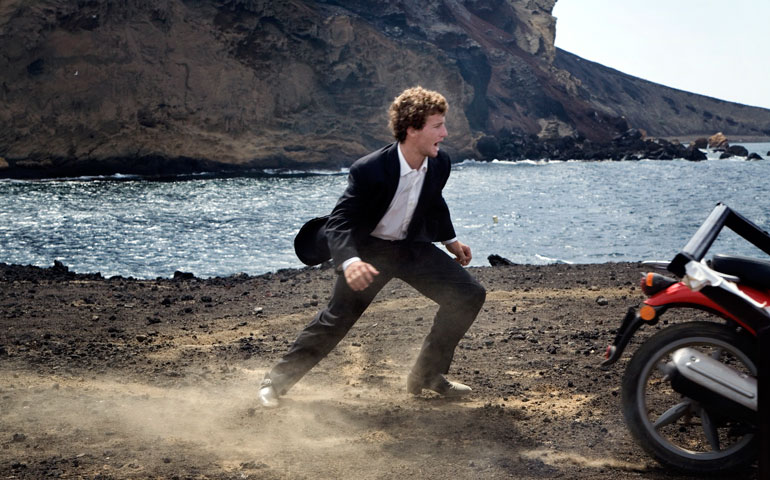
Filippo Pucillo stars as Filippo in “Terraferma.”
It is not without irony that a film titled “Terraferma,” the Italian term for “dry land,” would open with an underwater shot. We see the underside of a fishing boat trawling a net through the azure waters of the Mediterranean Sea. It is a good catch, and the chipper 19-year-old Filippo (Filippo Pucillo) does a happy dance at the stern before his amused grandfather Ernesto (Mimmo Cuticchio), a veteran fisherman.
But as they head back home to Lampedusa, a picturesque speck of an island in the southernmost part of Italy, they run into the debris of a capsized boat, causing serious damage to the propeller of their fishing boat.
Life in Lampedusa is both idyllic and harsh. Filippo lost his father to the sea three years ago. His widowed mother, Giulietta (Donatella Finocchiarro), is bent on selling their house to start life anew on the mainland; in the meantime, she decides to move their living quarters to the garage and rent out the main house to tourists.
His uncle Nino (Beppe Fiorello), a self-styled tour organizer, is pushing Ernesto to sell the decaying fishing boat, a prospect the old fisherman spurns. Filippo struggles to make sense of the discomposure on top of his fair share of teenage angst.
In its first half-hour, Emanuele Crialese’s “Terraferma” brings to mind a number of small-scale Italian films that draw attention to the day-to-day concerns of gritty but charming townsfolk, among them, his own “Respiro” (2002), which is also set in Lampedusa. One-third through the film, however, an unanticipated twist sends “Terraferma” on another course, turning it into a compelling human drama with social questions far bigger than what life in the quaint fishing community normally throws at its residents.
While setting sail to fish, Filippo and Ernesto encounter a boat crammed with African refugees. The old fisherman immediately radios the coast guard and receives orders to keep distance, but some of the refugees had already jumped into the water in a desperate dash for the fishing boat. Without a thought, Ernesto rescues them.
Of the five refugees taken aboard, the three men run off and disappear; the other two, a young boy and a pregnant woman, find shelter in Giulietta’s garage home.
When authorities interrogate Ernesto about the incident, they hold him liable for “aiding and abetting illegal immigration” and confiscate his boat.
Filled with consternation, the old fisherman retorts, “Do you know the law of the sea?”
The law of the sea provides that persons who are in distress at sea must be immediately rescued; legal questions are to be sorted out after. The moral imperative is held sacrosanct by international maritime law and custom, but tensions come to a boil when the law of the sea clashes with the law of the land.
In a heated community meeting, the older generation of fishermen led by Ernesto argues for the “rescue first” option, while members of the younger generation, who depend on tourism for income, find a mouthpiece in Nino, who argues against it.
The moral riptide is further dramatized when Filippo, poised for a romantic evening at sea with a pretty tourist, runs into a bevy of refugees, flailing in the water in a mad scramble to board his small boat. Panic-stricken, Filippo fends off the refugees with a pole and sails away posthaste.
The following morning, the beach is strewn with half-drowned refugees, prompting a compassionate response from the startled tourists who immediately attend to them. Shamed, Filippo could only bolt away.
While “Terraferma” pays attention to the complex sociopolitical realities swirling around the refugee question, the heart of the film is the intimate human drama between Giulietta and Sara (Timnit T.), the African refugee who gives birth in the garage home. Giulietta is in a Catch-22 pendulum, torn between her solidarity with a woman who, like her, is a burdened mother, and her fear of breaking the law and compromising the fragile stability of her own family. She instinctively offers assistance to her uninvited guest and her children, but issues stern warnings that they will have to leave soon.
Despite Sara’s failed attempts to connect with her unwilling host, the bond between them as mothers is perceptible. The camera often frames the two women in a face-to-face position and the poetics of their gaze belie the wall that alienates them.
Gradually, Giulietta’s hard veneer begins to thaw as she listens to the refugee’s story. She learns that en route to Lampedusa, Sara was thrown into prison in Libya, where she was raped and impregnated by a police officer. The child she decided to keep is the very one she had given birth to.
At a later turn, when the mothers stand before each other for the last time, the refugee quietly sheds tears and utters, “I am sorry, Giulietta. I am sorry, Giulietta.” Moved with compassion, Giulietta responds with an earnest embrace.
Meaningfully, the image of the Virgin Mary appears at key turns in the film. In the opening sequence, we see a small statue positioned on the dashboard of Ernesto’s boat; and again, moments before they encounter the boatload of refugees. On the third instance, the camera pans on an undersea grotto of a life-size, seaweed-draped statue of the Virgin Mary, just following the scene when refugees are washed ashore.
Consonant with the mother motif between Giulietta and Sara, it is reasonable to interpret this as a symbolic appeal for motherly compassion. Mary of Nazareth, after all, is the proto-refugee; she knows about the ordeal of having to flee for sanctuary while heavy with child, only to find that there is no room in the inn.
In April, the world was shocked by headlines reporting that hundreds of refugees had drowned along the coast of Lampedusa. Closer to Africa than it is to the Italian mainland, the island is, by default, the site of first rescue. For its small community, the pendulum between the law of the sea and the law of the land continues.
The film does not propose a definitive solution to the crisis, it simply cannot. But one carry-out value from my viewing is this: Behind every refugee story is a human story.
The irony is not lost; “Terraferma,” dry land, has everything to do with the sea.
[Precious Blood Br. Antonio D. Sison is author of World Cinema, Theology, and the Human (2012), and is a faculty member at Catholic Theological Union, Chicago. “Terraferma” is available on DVD and Blu-ray from Cohen Media Group.]



